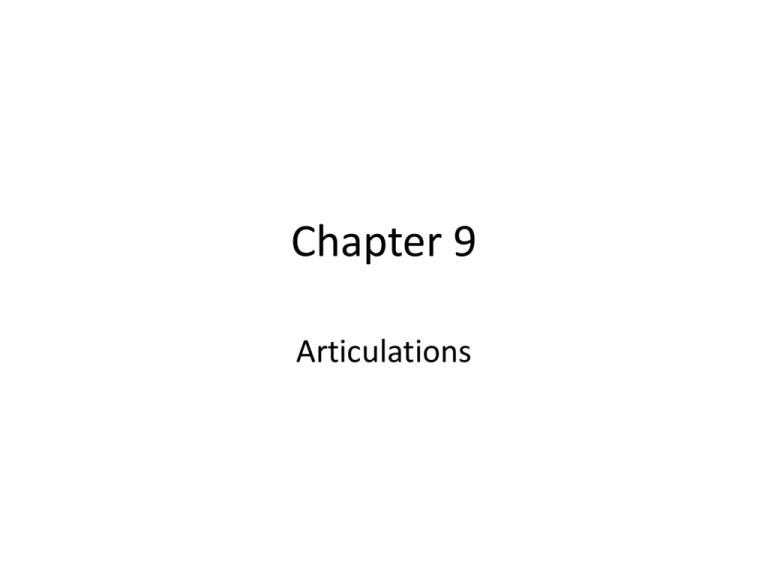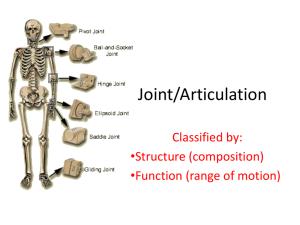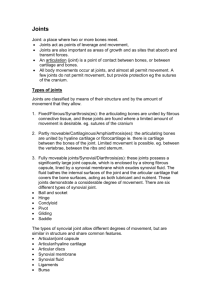Joint
advertisement

Chapter 9 Articulations Articulations • Point of contact between bones. • Joint- mostly very movable but some are immovable or only allow limited motions. • Movable joints allow complex, highly coordinated movements. Classifications • Structural classification- joints are named according to: – Type of connective tissue – Presence of fluid filled joint capsules • Functional classification– Synarthroses- immovable – Amphiarthroses- slightly movable – Diarthroses- freely movable Fibrous Joints • Synarthroses • Bones of joints fit together closely, allowing little or no movement. – Syndesmoses- joints in which ligaments connect two bones. – Sutures- found only in skull; toothlike projections from adjacent bones interlock with each other. – Gomphoses- between root of a tooth and the alveolar process of mandible and maxilla. Cartilaginous joints • Bones of joints are joined together by hyaline cartilage of fibrocartilage; allow very little motion. Synovial joints • Freely movable joints – Structures: • • • • • • • Joint capsule Synovial membrane Articular cartilage Joint cavity Menisci Ligaments Bursae Types of Synovial Joints • Uniaxial joints – Hinge joints- knee, elbow – Pivot joints- neck/vertebrae, radius • Biaxial joints – Saddle joints- thumbs – Condyloid joints- hips, shoulders Types of Synovial Joints • Multiaxial joints – Ball and socket joint- shoulder, femur – Gliding joint- wrists, vertebrae Humeroscapular Joint • Shoulder joint • Most mobile joint because of glenoid cavity • Glenoid labrum Elbow Joint • Humeroradius joint • Humeroulnar joint • Both components of elbow joint surrounded by single joint capsule and stabilized by collateral ligaments. Hip Joint • Stable joint Knee Joint • Largest and one of the most complex and most frequently injured joints. • Tibiofemoral joint- supported by joint capsule, cartilage, ligaments, and tendons. • Permits flexion and extension Ankle Joint • Hinge type of synovial joint • Articulation between lower ends of tibia and fibula and upper part of talus. • Joint is “mortise” or wedge-shaped. – Lateral malleolus lower than medial. Measuring Range of Motion • Range of motion (ROM) assessment used to determine extent of joint injury. • ROM can be measured actively or passively; results of both by instrument called goniometer. Angular Movement • Change in the size of angle between articulating bones. – Flexion- decreases angle between bones; bends or folds one part on another. – Extension- increases angle between two bones. – Hyperextension- extension between bones of a joint that is greater than normal. – Plantar flexion- increases angle between top of foot and front of leg. Angular Movement – Dorsi flexion- decreases angle between top of foot and front of leg. – Abduction- moves part away from median plan of body. – Adduction- moves a part toward median plane of body. Circular Movements • Rotation- pivoting a bone on its own axis. • Circumduction- moves a part so that its distal end moves in a circle. • Supination- turns the hand palm side-up. • Pronation- turns the hand palm side-down. Gliding Movements • Simplest of all movements; articular surface of one bone moves over articular surface of another without any angular or circular movement. Special Movements • • • • • • Inversion- turning sole of foot inward. Eversion- turning sole outward. Protraction- moves a part forward. Retraction- moves part backward. Elevation- moves part up. Depression- lowers a part.






